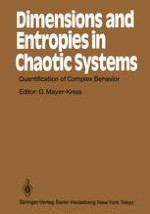These proceedings contain the papers contributed to the International Work shop on "Dimensions and Entropies in Chaotic Systems" at the Pecos River Conference Center on the Pecos River Ranch in Spetember 1985. The work shop was held by the Center for Nonlinear Studies of the Los Alamos National Laboratory. At the Center for Nonlinear Studies the investigation of chaotic dynamics and especially the quantification of complex behavior has a long tradition. In spite of some remarkable successes, there are fundamental, as well as nu merical, problems involved in the practical realization of these algorithms. This has led to a series of publications in which modifications and improve ments of the original methods have been proposed. At present there exists a growing number of competing dimension algorithms but no comprehensive review explaining how they are related. Further, in actual experimental ap plications, rather than a precise algorithm, one finds frequent use of "rules of thumb" together with error estimates which, in many cases, appear to be far too optimistic. Also it seems that questions like "What is the maximal dimension of an attractor that one can measure with a given number of data points and a given experimental resolution?" have still not been answered in a satisfactory manner for general cases.
